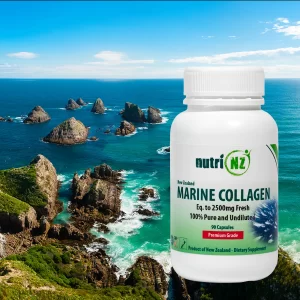Why Marine Collagen over other Animal Collagen?
Other animal collagen is typically made from beef and/or pork skin; in these cases it is very hard to remove calcium and fatty ingredients. However, Marine Collagen does not contain these components, making it a much purer, more beneficial and easily absorbed supplement. This also means that people on a diet or people who have high blood pressure have no problem in consuming the supplement.
What is Type II Collagen?
Collagen refers to natural protein that can be found in various parts of the body, including the skin and bones. The differences between the collagen types are generally based on their unique chemical compositions. Type II collagen is prominently found in cartilage and also in the vitreous humour. This type of collagen is used for the treatment of several conditions, including arthritis, cellulite, muscles, tendons, skin, hair and nails.
Tests have shown that type II collagen contains a substance known as chondroitin sulphate. This compound has been credited with having an anti-inflammatory effect on certain connective tissues of the body. Many studies have concluded that this compound is safer and has fewer side effects than other anti-inflammatory preparations.
Is Marine Collagen better than hydrolysed collagen?
High quality collagen powders are hydrolysed, meaning they are broken up into smaller peptides that are easier for our bodies to use. Because it consists of these smaller peptides, marine collagen has superior bioavailability than other types of
collagen.
Can men use collagen as well?
Yes! Collagen can help man support their muscle, joints, ligaments, skin and hair growth.
What’s in collagen?
Collagen is composed of a series of amino acids, including glutamine, arginine, proline and glycine. Amino acids are the building blocks for proteins and are essential to synthesizing hormones and moving chemical messages through the body.
As for collagen, amino acids bind together to form procollagen, a precursor for the protein that’s still strong enough to provide strength and structure. To become collagen, procollagen undergoes a grouping process, forming long collagen chains with more than a thousand amino acids. Those chains arrange themselves side by side and bind together into fibrils, or three-dimensional helices. Many of the unique capabilities of collagen – for example, being elastic and forgiving enough to be stretched without tearing – are thanks to the unique properties of these triple helices. They bind closely together to form a dense sheath of cells and act as the foundation of body materials, whether it’s in your epidermis (upper layer of skin), your gut, or anywhere else.
What’s made from collagen?
Your body’s cells, skeleton and internal organs are held together by collagen. Collagen fibrils bind side by side, these are the foundation of tissues that make up organs, including our largest organ – the skin. Collagen is also a fundamental element of bones, when combined with minerals. It even makes up the majority of tendons and cartilage. Nails, hair, muscles and teeth are also made from collagen.






Reviews
There are no reviews yet.